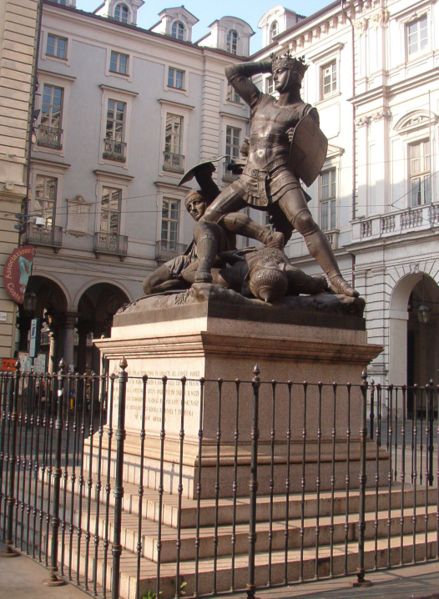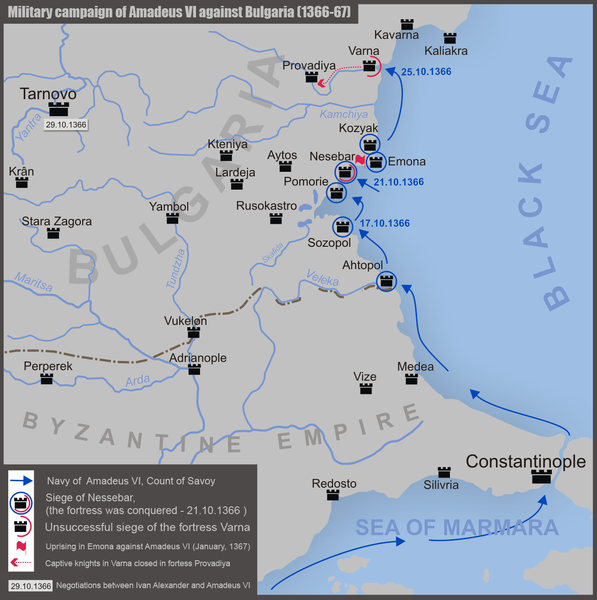<Back to Index>
- Philologist Jakob Ludwig Karl Grimm, 1785
- Painter Augustus Edwin John, 1878
- Count of Savoy Amadeus VI, 1334
PAGE SPONSOR


Amadeus VI (January 4, 1334, Chambéry – March 1, 1383), surnamed the Green Count (Italian: Il Conte Verde) was Count of Savoy from 1343 to 1383. He was the eldest son of Aimone, Count of Savoy, and Yolande of Montferrat.
In 1349 Humbert II de La Tour du Pin, Dauphin de Viennois, the last Dauphin de Viennois, surrendered his title and principality to the future Charles V of France. At the time the new Dauphin was grandson of current King Philip VI of France and son to his Heir Apparent, the later John II of France. Humbert II retired into a Dominican monastery. Amadeus, angered by this cessation, which had created a formidable neighbour to Savoy, went to war with France, which he defeated in 1354.
In a treaty concluded in Paris in the following year Amadeus agreed to exchange territory in Dauphiné beyond the rivers Rhone and Guiers, in exchange for recognition as the undisputed sovereign of Faucigny and the county of Gex, as well as becoming the suzerain lord over the Counts of Genevois, all of whose titles had been the subject of earlier contention between the Counts of Savoy and the Dauphins of Viennois. Amadeus also forced the Marquess of Saluzzoto pay him tribute, thus extending his rule to the Italian side of the Alps.
Amadeus was credited with purchasing the territory of the mountain pass, the Col de Largentièes, today Maddalena Pass on the border of France and Italy, for the sum of 60,000 ecus, it was of such strategic and commercial importance. The Col de Largentière historically linked Lyon with Italy; it offered an easy route between Piedmont and the outlying valley of Barcelonnette, which came into Savoyard possession when Amadeus or his heir transferred it from the County of Provence to the County of Nice.
This made him an important player in the politics of Northern Italy. The Republic of Genoa and the Republic of Venice had for long argued over the ownership of the island of Tenedos in the Aegean Sea. Eventually it was agreed that the Island should be entrusted to the Count of Savoy. Later Amadeus would be persuaded by Pope Clement VII to accompany Louis I of Naples on an expedition to Naples. Here in 1382 the Count would share with Louis in the successful conquests of Abruzzi and Apulia. Amadeus initiated a minor crusade (with 15 ships and 1,700 men) in 1366 against Murad I of the Ottoman Empire to aid his cousin, John V Palaiologos, the Byzantine Emperor. On this campaign Amadeus joined forces with Francesco I of Lesbos, and Hungarian king Louis the Great, and they drove the Turks from Gallipoli. At this time John V was held captive by the Bulgarians. Amadeus turned his forces against Bulgaria and captured the Black Sea ports of Mesembria and Sozopolis. He then laid siege to Varna and sent Tsar Ivan Alexander an
ultimatum to release John V or suffer further defeat. Ivan Alexander
released John V and Amadeus returned to spend the winter in Mesembria,
arriving there with John V before Christmas. The nickname the Green Count refers to his habit of dressing in this colour and appear in state occasions surrounded by green dressed escort. He created a system of state-supported poor relief, one of the first of its kind in the late medieval world. In 1381 at Turin, he mediated between Genoa and Venice and sponsored the peace treaty which brought and end to the War of Chioggia and the larger Venetian - Genoese War. He died at Campobasso in 1383. He was married in 1355 in Paris to Bonne of Bourbon, the sister-in-law of Charles V of France. They had two children: Amadeus VII (1360 - November 1, 1391); he married Bonne of Berry (1365 – 1435), daughter of Duke John of Berry and a niece of Bonne of Bourbon, and Louis of Savoy (1362 - 1365).